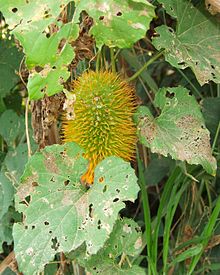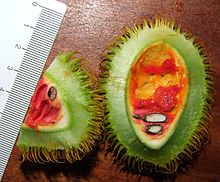- Momordica foetida
-
Momordica foetida Scientific classification Kingdom: Plantae (unranked): Angiosperms (unranked): Eudicots (unranked): Rosids Order: Cucurbitales Family: Cucurbitaceae Genus: Momordica Species: M. foetida Binomial name Momordica foetida
Schumach.Momordica foetida is a perennial climbing vine native of tropical Africa, closely related to the bitter melon (M. charantia) and balsam apple (M. balsamina). Its species name ("bad-smelling") refers to its unpleasant smell. It was previously named M. morkorra (A. Rich)[1] and M. cordata (Cogn.)[2]
The plant grows in forest edges and similar habitats (including disturbed and cultivated land), woodland, and wooded grassland. Its leaves are wrinkled, heart-shaped with irregular edges, up to 18 cm wide. The flowers are yellow to yellow-orange. The fruit is a prolate spheroid, 3.5–7.5 cm long and 2.5–5 cm wide, bright orange and covered with soft spines. When fully ripe it splits from the bottom into three valves, exposing a cluster of black seeds, individually covered by a bright red, sticky, sweet pulp. The plant has perennial tuberous roots.
Local names for the plant include concombre sauvage (French for "wild cucumber"), nyanya-nua, sσprσpσ, kakle, awoduan ("snake food"), aoasongo, gaayama, nanïa, n-gessannia, boobo, bobonowron, vovolé, vovoné vono, hepa, ìsúgū, alu-osi, akb’an’udene, ejìnrìn, tsekiri, and a-bos-a-wir.[2]
Contents
Uses
Food
The leaves have a bitter taste but it is eaten in Gabon and Malawi. The fruit is edible and is consumed in various countries, including Ghana, Gabon, Sudan and Tanganyika. The root is considered edible in Sudan.[2]
Folk medicine
Like its relative M. chrantia, the plant contains a number of bioactive compounds, including sitosteryl glucoside, 5,25-stigmastadien-3β-yl glucoside, and 1β-hydroxyfriedel-6-en-3-one, and several cucurbitane-type triterpenoid derivatives.[3]
Digestive disorders
In Tanganika young leaves are taken for stomach ache and the root is considered a purgative. The Edo of Nigeria drink leaf sap for intestinal disorders. The Igbo take it for iba ozi. In Gabon the leaves are used as emetic and for enemas. The leaf is also as used against roundworm.[2]
Pain relief
The leaf sap is used to treat severe headache and earache. In Malawi headache is reated by binding the head with the plant stem.
Reproduction
In the Ivory Coast a preparation of the leaves is used as an aphrodisiac and is taken by women as an emmenagogue and as childbirth helper. In Uganda tea from leaves or roots are used as an abortifacient and an ecbolic.[2]
Skin conditions
In the Ivory Coast a leaf-decoction is used to treat smallpox. The root is used in Tanganyika to wash small children and mothers' breasts. In South Africa a root decoction with other plants is taken for boils.[2]
Snake bites
The inflammation caused by the venom of the spitting cobra, (Naja nigrocollis) can be prevented by promptly rubbing the skin with crushed leaves and chewing them. The leaf sap is drunk to treat snakebite.[2]
Other conditions
The leaf sap is used to stop nose bleeding. In Tanganyika the young leaves are used to treat dropsy and malaria.[2]
Other uses
In Malawi the fruit is used as bait to trap birds. In Gabon, leaves are soaked, dried in the sun, and used to stuff cushions. In Tanganyika the fruit pulp is believed to be poisonous to weevils, moths and ants and is used as an insect repellant. The plant's presence is believed to be an indicator that the soil is appropriate for cacao.[2]
See also
- Momordica balsamina (balsam apple)
- Momordica charantia (bitter melon)
- Momordica cochinchinensis
References
- ^ C. Jeffrey (1978) Cucurbitaceae. Volume 4 of Flora Zambesiaca
- ^ a b c d e f g h i H. M. Burkill (1985). The useful plants of west tropical Africa, volume 1.
- ^ Dulcie A. Mulholland, Vikash Sewram, Roy Osborne, Karl H. Pegel and Joseph D. Connolly (1997),Cucurbitane triterpenoids from the leaves of Momordica foetida. Phytochemistry, volume 45, issue 2, pages 391-395. doi:10.1016/S0031-9422(96)00814-X

This Cucurbitales article is a stub. You can help Wikipedia by expanding it.



